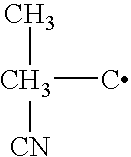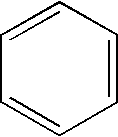Materials and methods for improving properties of SPD emulsions and films
- Summary
- Abstract
- Description
- Claims
- Application Information
AI Technical Summary
Benefits of technology
Problems solved by technology
Method used
Image
Examples
example 1
Synthesis and Evaluation of Diphenyldimethyl Siloxane-co-Laurylmethacrylate / 2-hydroxyethylmethacrylate Polymers as Emulsifiers for an SPD Emulsion System
[0040] In order to enhance the stability of SPD emulsions based on diphenyldimethyl siloxanes and laurylmethacrylate (“LMA”) / 2-hydroxyethylmethacrylate (“HEMA” or “2-HEMA”) random copolymers, a copolymer was synthesized in a two-step process which would yield a siloxane segment having pendant phenyl groups and a LMA / HEMA random copolymer-containing segment.
General Procedure for Synthesis of the Copolymer Emulsifier
[0041] The first step in the synthesis of the emulsifier involves preparing the siloxane segment of the emulsifier which comprises a disilanol-terminated diphenyl (14-18% by weight) dimethyl (86-82% by weight) siloxane (the major component in the matrix polymer synthesis) and reacting it with 3-acryloxypropyldimethylmethoxysilane. The siloxane segment of the emulsifier is similar to the siloxane segment of the matrix po...
example 2
Step 1
Synthesis of the Siloxane Segment
[0051] Into a three-neck, 500 mL round bottom flask the following materials were charged:
[0052] 50 g of purified disilanol terminated diphenylsiloxane-dimethylsiloxane and 200 ml of heptane. One port was used for mechanical mixing, the second port was used for setting up the Dean-Stark condensation assembly and the last port was used as the sampling port. The reaction mixture was refluxed for 30 minutes. At the end of 30 minutes, 0.04 g of stannous (II) octoate catalyst and 2 g of 3-acryloxypropyldimethylmethoxysilane (“3-Ac”) were introduced and the reflux continued for 90 minutes. At the end of 115 minutes, the temperature was reduced to 80° C. and 15 mL of trimethylmethoxysilane was introduced to cap chain ends that were not endcapped by 3-Ac. The endcapping reaction was carried out for 60 minutes. At the end of this reaction, the reaction mixture was poured into 250 mL of ethanol in a 1 L beaker and stirred. The reaction flask was rinsed...
example 3
Step 1
Synthesis of the Siloxane Segment
[0057] Into a three-neck, 2 L round bottom flask the following materials were charged:
[0058] 200 g of purified disilanol terminated diphenylsiloxane-dimethylsiloxane and 800 mL of heptane. One port was used for mechanical mixing, the second port was used for setting up the Dean-Stark condensation assembly and the last port was used as the sampling port. The reaction mixture was refluxed for 60 minutes. At the end of 90 minutes, 0.16 g of stannous (II) octoate catalyst and 8 g of 3-acryloxypropyldimethylmethoxysilane (“3-Ac”) were introduced and the reflux continued for 105 minutes. At the end of 105 minutes, the temperature was reduced to 60° C. and 15 mL of trimethylmethoxysilane was introduced to cap chain ends that were not endcapped by 3-Ac. The endcapping reaction was done for 60 minutes. At the end of this reaction, the reaction mixture was poured into 1 L of ethanol in a 5 L beaker and stirred. The reaction flask was rinsed with 200 m...
PUM
| Property | Measurement | Unit |
|---|---|---|
| Percent by mass | aaaaa | aaaaa |
| Angle | aaaaa | aaaaa |
| Percent by mass | aaaaa | aaaaa |
Abstract
Description
Claims
Application Information
 Login to View More
Login to View More - R&D
- Intellectual Property
- Life Sciences
- Materials
- Tech Scout
- Unparalleled Data Quality
- Higher Quality Content
- 60% Fewer Hallucinations
Browse by: Latest US Patents, China's latest patents, Technical Efficacy Thesaurus, Application Domain, Technology Topic, Popular Technical Reports.
© 2025 PatSnap. All rights reserved.Legal|Privacy policy|Modern Slavery Act Transparency Statement|Sitemap|About US| Contact US: help@patsnap.com



